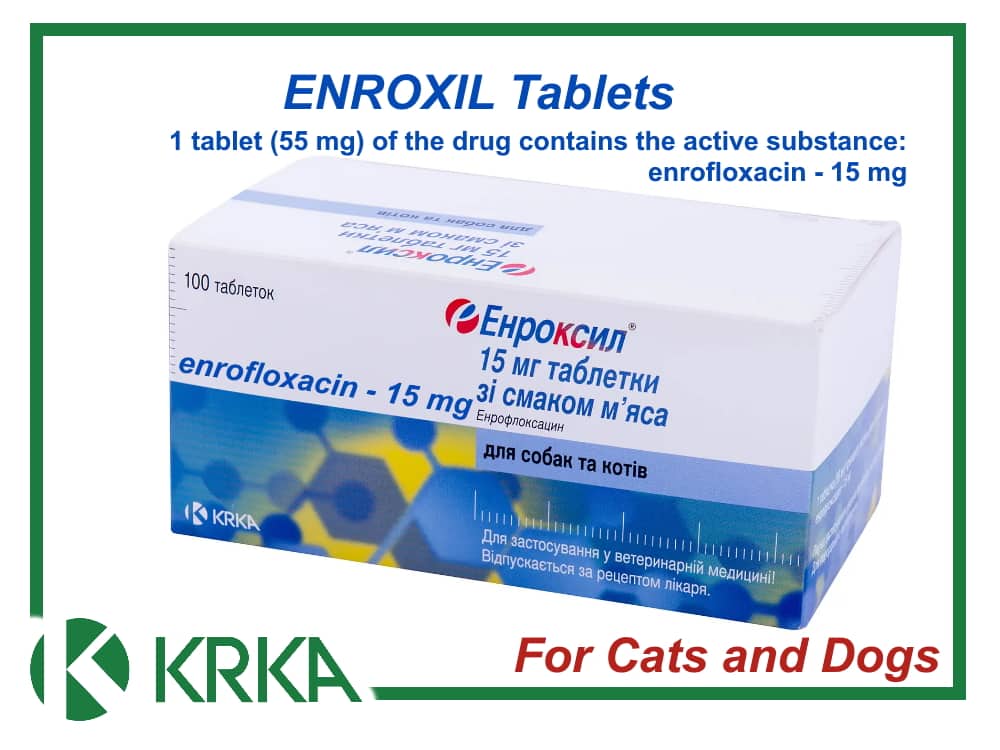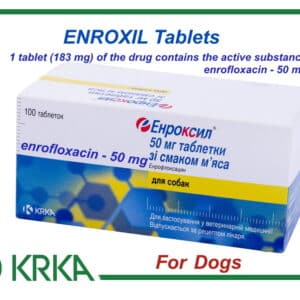Enroxil 15 (enrofloxacin – 15 mg) antibacterial veterinary drugs, 10 tablets * 3 pcs
Description
Slightly biconvex tablets with beveled edges, from cream to pale brown with possible white and dark spots.
Storage
1 tablet (55 mg) of the drug contains the active substance:
enrofloxacin – 15 mg.
Excipients: mannitol, corn starch, sodium starch glycolate, meat flavor 10022, acrylate copolymer, sodium lauryl sulfate, dibutyl sebacate, croscarmellose sodium, colloidal anhydrous silica, talc, magnesium stearate.
Pharmacological properties
ATC vet classification code QJ01 – antibacterial veterinary drugs for systemic use. QJ01MA90 – Enrofloxacin.
Enrofloxacin belongs to the group of fluoroquinolones. It is effective against most pathogenic microorganisms: Mycoplasma spp., E. coli, Salmonella spp., Campylobacter spp., Haemophilus spp., Pasteurella spp., Bordetella spp., Erysipelothrix rhusiopathiae, Klebsiella spp., Proteus spp., Proteus spp. Staphylococcus aureus, Streptococcus spp., Clostridium perfringens, Actinobacillus spp., and enterococci. Enrofloxacin has antimicrobial activity by inhibiting the activity of the enzyme DNA gyrase, which is a catalyst for DNA replication in bacterial cell. Inhibition of DNA gyrase activity leads to functional disorders, blocking cell biosynthesis and the death of the pathogen. Has a bactericidal effect, especially against microorganisms resistant to beta-lactam antibiotics, tetracyclines,
In studies in dogs using enrofloxacin at a dose of 4.91 mg/kg body weight, the maximum plasma concentration of 1179.94 ± 260.83 ng/ml was reached after 1.57 ± 0.62 hours. The half-life is 3.78 hours.
Almost 40% of enrofloxacin administered orally to dogs is converted to ciprofloxacin. The maximum plasma concentration of ciprofloxacin reaches 491.99 ± 57.95 ng/mg. Tmax is 1.79 ± 2.6 hours The half-life is 5.10 hours.
Enrofloxacin enters the tissues rapidly. The concentration in tissues and tissue fluids is 2-3 times higher than the concentration in blood serum. High levels of enrofloxacin are observed in the lungs, liver, kidneys, skin, bones, and lymphatic system. Enrofloxacin also enters the cerebrospinal fluid, intraocular fluid, and the fetus of pregnant animals.
Enrofloxacin is excreted mainly in the urine.
Application
Treatment of dogs and cats for diseases of the digestive tract, respiratory and genitourinary systems, skin and ears (otitis externa), secondary wound infections caused by microorganisms sensitive to enrofloxacin.
Dosage
Orally at a dose of 5 mg of enrofloxacin per 1 kg of body weight (1 tablet per 3 kg of body weight) per day once or 2.5 mg (1/2 tablet per 3 kg of body weight) twice a day, regardless of feeding.
The duration of treatment is 5 – 10 days.
*Kilograms to a Pounds conversion table
| Kilograms (kg) | Pounds (lb) | Pounds+Ounces (lb+oz) |
| 0.1 kg | 0.220 lb | 0 lb 3.527 oz |
| 1 kg | 2.205 lb | 2 lb 3.274 oz |
| 5 kg | 11.023 lb | 11 lb 0.370 oz |
| 10 kg | 22.046 lb | 22 lb 0.740 oz |
Contraindication
Hypersensitivity to enrofloxacin.
Do not use in the detection of resistant strains of pathogenic bacteria resistant to quinolones.
Do not use in dogs of small breeds in the first 12 months of life and dogs of large breeds – in the first 18 months of life.
Not recommended for use in cats in the first 8 weeks of life.
Do not use in animals with signs of central nervous system disease.
Do not use simultaneously with tetracycline drugs, macrolides, chloramphenicol, theophylline.
Enrofloxacin should not be used prophylactically.
Reservation
Drugs from the group of quinolones provoke damage to the cartilage of the joints caused by weight gain and other forms of arthropathy in young animals that are growing rapidly. Use with caution in dogs with severe renal and hepatic impairment.
Release form
10 tablets in a blister, 1 or 10 blisters in a cardboard package.
Storage
Dry, dark, inaccessible to children at a temperature of 5 ° C to 25 ° C.
Shelf life – 3 years. Half the tablet can be returned to the blister and used within 24 hours.
For use in veterinary medicine!









































































